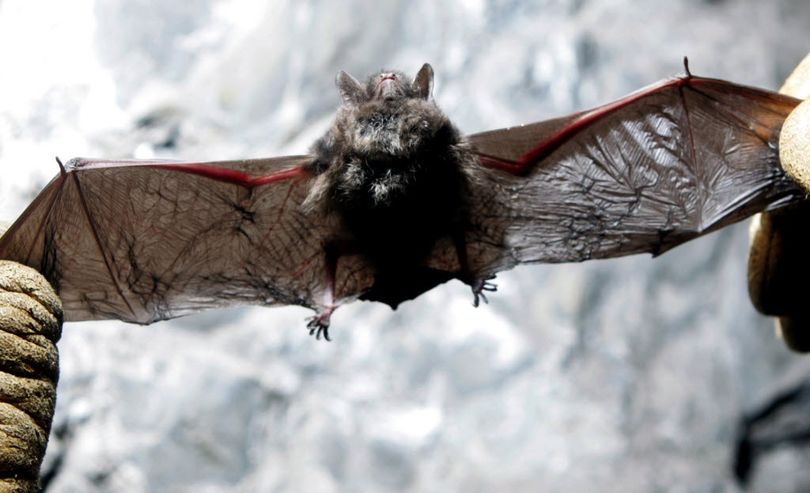Bats, wolves prominent in Wildlife Society’s top 2011 stories list

WILDLIFE -- Gov. Butch Otter cried wolf by declaring the predators a "disaster emergency" in Idaho last year, according to The Wildlife Society, the international organization of wildlife professionals.
The group's newsletter editors ranked that story No. 1 in their list of Top 10 Wildlife News Stories for 2011.
Other top stories include white-nose syndrome in bats plus stories on wolves, pronghorns and my column in The Spokesman-Review about a Wenatchee-area trail-cam that caught eight cougars in one photo. (Unfortunately, the Wildlife Society linked to a watered-down rewrite by somebody else.)
Read on to see the group's top wildlife stories.
Idaho governor declares wolves a 'disaster emergency'
Reuters Share 



From April 22, 2011: Idaho Gov. Butch Otter has signed a bill declaring the gray wolf a "disaster emergency" in his state, days after Congress voted to strip the animal of federal protections there and in Montana. Despite enactment of federal legislation turning wolf control over to state wildlife management and allowing licensed hunting of the animals, Otter welcomed his new authority to bring law enforcement to bear against any wolf threats to humans or livestock. More
Fish and Wildlife Service unveils plan to combat white-nose syndrome in bats
U.S. Fish and Wildlife Service Share 



From May 20, 2011: The U.S. Fish and Wildlife Service has unveiled a national management plan to address the threat posed by white-nose syndrome, which has killed more than a million hibernating bats in eastern North America since it was discovered near Albany, N.Y., in 2006. More
Deer and antelope in Colorado's northern mountains declining
The Denver Post Share 



From Aug. 12, 2011: Deer and antelope populations in Colorado's northern mountain valleys have declined sharply over the past 30 years — pronghorn by as much as 64 percent in some areas, mule deer by up to 36 percent — according to a new National Wildlife Federation study. More
Study: Fungus alone is killing off bats
LiveScience Share 



From Oct. 28, 2011: The disease decimating bat populations in the northeastern United States is caused solely by a fungus, without the help of other agents or pre-existing health conditions, experiments have confirmed. White nose syndrome, first reported in 2006 in New York state, has spread to Indiana, Kentucky and Tennessee, and scientists still are not sure how it kills. Some have worried that it could lead to the extinction of North America's most common bat. More
Gray wolf debate lands in Oregon legislature; ranchers want compensation and right to shoot
The Oregonian Share 



From April 1, 2011: In a debate older than the state of Oregon, ranchers have told legislators that wolves are costing them money and peace of mind. Since wolves were reintroduced to Yellowstone National Park in 1995, their populations in Wyoming, Idaho and Montana, eastern Washington and eastern Oregon have grown to nearly 1,500. Conflict has followed. More
Future is grim for deer in Wyoming
Wyoming Tribune-Eagle Share 



From Aug. 19, 2011: Mule deer populations are dropping. It's so bad, in fact, some question whether the animal will even be a part of the Wyoming landscape further on down the road. More
'Pork choppers' go to work as feral hog season opens in Texas
Abilene Reporter-News Share 



From Sept. 2, 2011: A new Texas state law has gone into effect that allows people to pay to hunt hogs from helicopters, or what some have nicknamed "pork choppers." As a helicopter flushes hogs out into the open, the pilot maneuvers it into position and tells the hunter when to shoot and when not to shoot. The helicopter flies about 10 to 20 feet above the ground, and sometimes only 4 to 6 feet. More
US Interior announces $53 million in grants to support habitat acquisition and conservation planning for endangered species
U.S. Department of the Interior Share 



From Aug. 26, 2011: Secretary of the Interior Ken Salazar has announced more than $53 million in grants to 17 states to support conservation planning and acquisition of vital habitat for threatened and endangered fish, wildlife and plants. The grants, awarded through the U.S. Fish and Wildlife Service's Cooperative Endangered Species Conservation Fund, will benefit numerous imperiled species ranging from the Peninsular bighorn sheep to the Karner blue butterfly.MoreLoggerhead turtle movements revealed for the first time
PlanetEarth Online Share 



From June 24, 2011: Satellite tracking technology has revealed in detail for the first time the annual movements of thousands of loggerhead turtles that live off the east coast of the U.S. The 10-year study shows that they go back to the same spots year after year. This means researchers can now say where, to within a few tens of miles, the turtles will turn up at any point during the year.More
Rare cougar family reunion caught on camera
Life's Little Mysteries Share 



From April 8, 2011: Whether you call them cougars, panthers, mountain lions or pumas, you can usually leave off the "s." These elusive cats almost always work solo. Shocking new photos, taken with a night camera by a hunter in Wenatchee, Wash., show eight of the predators crowded around a cow carcass. Officials at the Washington Department of Fish and Wildlife say the scene is extremely rare.More
